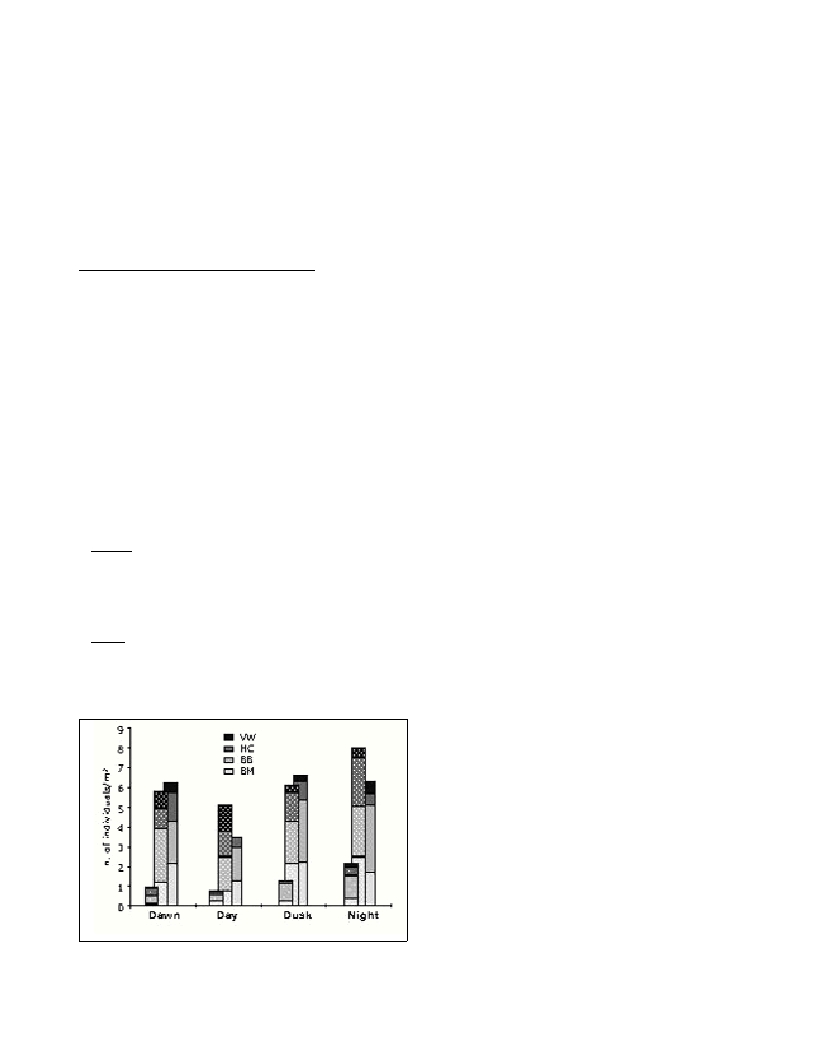UNVEILING THE SECRETS OF A SUCCESSFUL INVADER: PRELIMINARY DATA ON THE BIOLOGY
AND THE ECOLOGY OF THE CRAB PERCNON GIBBESI(H. MILNE EDWARDS, 1853)
Stefano Cannicci
1
*, Fabio Badalamenti
2
, Marco Milazzo
3
, Marina Gomei
1
, Alba Baccarella
2
& Marco Vannini
1
1
Dipartimento di Biologia Animale e Genetica “Leo Pardi”, Università degli Studi Firenze, Italy - * cannicci@dbag.unifi.it,
gomei@unifi.it ; vannini_m@dbag.unifi.it
2
CNR-IAMC Laboratorio di Biologia Marina, Castellammare del Golfo (Tp), italy - fbadala@tin.it
3
Dipartimento di Biologia Animale, Università di Palermo, Palermo, Italy - marmilazzo@iol.it
Abstract
The great increase of human activities in the sea has contributed to the transformation of the natural geographical ranges of species. In the
Mediterranean Sea the invasion of alien species has increased enormously in the last years and one of the most successful invaders is the
decapod crustacean Percnon gibbesi, presumably arriving from the Atlantic Ocean. This work offers a preliminary account on structure,
bathymetric distribution, microhabitat preference and diet of a population newly recorded in northwestern Sicily. Our data, although
preliminary, demonstrate that the studied population is now perfectly adapted to the colonized shores.
Keywords: alien, Percnon gibbesi, diet, habitat
Rapp. Comm. int. Mer Médit., 37,2004
326
Updated distribution in the Mediterranean Sea
One of the most successful marine invaders in the Mediterranean
Sea is the decapod Percnon gibbesi, presumably arriving from the
Atlantic Ocean, through vectors still to be identified. Percnon gibbesi
is a subtropical species, distributed along the American Pacific coast,
and both sides of the Atlantic Ocean (1, 2). Its presence in the
Mediterranean Sea was first recorded in the summer of 1999:
contemporaneously reported from the Balear Islands, Spain, (3, 4),
southeastern Sicily, (5) and the Straits of Sicily (6). In 2000, the crab
was recorded at Pantelleria and Ustica islands, along northwestern
and eastern Sicily (7, 2). The most recent records come from northern
Sicily, Tyrrhenian coast of Calabria (2), Malta (2), Ionic coast of
Sicily, Ischia and Ponza Islands and Southern Sardinia.
The present contribution aims at (1) showing the results of preli-
minary field and lab work on the spatial and feeding preferences of
individuals of P. gibbesibelonging to a newly recorded population
(northwestern Sicily); (2) insights fpr the success of this alien species
in the Mediterranean Sea.
Microhabitat preferences and natural diet
Methods
. In order to assess habitat preferences, underwater surveys
were carried out during the summer of 2003 in the MPA of Capo
Gallo – Isola delle Femmine (northwestern Sicily). Individual
specimens belonging to different size classes were randomly chosen
and their occurrence within the different microhabitats and
behavioural patterns were recorded. A total of 44 specimens were
collected from two sites of the MPA for stomach contents analysis (8).
Results
.Percnon gibbesicolonised the shallow subtidal, between
0.5 and 3 m depth. Our data show a strong preference for large
submerged boulders, bare or with a limited macroalgal cover. Both
small and large crabs prefer these microhabitats, while medium-size
individuals are common in all microhabitats. Individuals of all size
classes are more active at dusk, daytime activity is minimal (Fig. 1).
All crabs showed a high fidelity to individual areas. Active small- and
medium-size crabs forage for about 50% of the time, while large
males were also patrolling their activity areas. Interspecific
interactions were rarely spotted and were directed at the ornate wrasse
Thalassoma pavoand the rainbow wrasse Coris julis.
Percnon gibbesiis an omnivor (animal matter = 43.2% ±7.47). A
total of 27 taxa were identified from stomach contents, accounting for
a generalistic, broad range, diet composition. The multivariate
analyses showed no difference in diet composition related to sex and
size. However, differences occurred between the diet of the two sub-
populations sampled (ANOSIM test, 2-way crossed; factor size:
R=0.118, p=0.833; factor sub-population R=0.151, p=0.03). The
preferred food items of the two sub-populations were gastropods and
Gelidiumsp. (Rhodophyta) and crustaceans and Cladophorasp.
(Chlorophyta), respectively.
Conclusions
This Atlantic invader is still fast spreading along the rocky subtidal
habitat of the Italian waters and our preliminary results allow some
hypotheses on its success. Percnon gibbesicolonises bathymetric
zone and microhabitat previously free from autoctonous large-size
benthic algal browsers, and its plastic feeding habits provide it with a
powerful tool to colonise new habitats.
References
1-d’Udekem d’Acoz C., 1999. Inventaire et distribution des crustacés
décapodes de l’Atlantique nord-oriental, de la Méditerranée et des eaux
continentales adjacentes au nord de 25°N. Publ. scient. M.N.H.N., 40: 383.
2-Galil B., Froglia C., and Noel P., 2002. CIESM Atlas of exotic species
in the Mediterranean. Vol. 2. Crustaceans: decapods and stomatopods.
CIESM, Monaco. 192 p.
3-Garcia L., and Reviriego B., 2000. Presència del cranc subtropical
Percnon gibbesi (H. Milne Edwards, 1853) (Crustacea, Decapoda,
Grapsidae) a les Illes Balears. Primera cita a la Mediterrania occidental.
Boll. Soc. Hist. Nat. Balears, 43: 81-89.
4-Müller C., 2001. Erstnachweis der Flachkrabbe Percnon gibbesi
(Crustacea: Decapoda: Grapsidae) für die Balearischen Inseln. Senckenb.
marit., 31(1): 83-89.
5-Mori M., and Vacchi M., 2002. On a new occurrence of the alien ?at
crab, Percnon gibbesi (H. Milne Edwards), in the southern Sicily (central
Mediterranean sea) (Crustacea, Brachyura, Grapsidae). Ann. Mus. Civ. St.
Nat. “G. Doria”, 94: 295-301.
6-Relini M., Orsi L., Puccio V., and Azzurro E., 2000. The exotic crab
Percnon gibbesi (H. Milne Edwards, 1853) (Decapoda, Grapsidae) in the
Central Mediterranean. Sci. Mar., 64(3): 337-340.
7-Pipitone C., Badalamenti F., and Sparrow A., 2001. Contribution to the
knowledge of Percnon gibbesi(Decapoda, Grapsidae), an exotic species
spreading rapidly in Sicilian waters. Crustaceana, 74(10): 1009-1017.
8-Cannicci S., Gomei M., Boddi B., and Vannini M., 2002. Feeding
habits and natural diet of the intertidal crab Pachygrapsus marmoratus:
Opportunistic browser or selective feeder? Estuar Coast Shelf Sci, 54 (6):
983-1001.
Fig. 1. Average density of P. gibbesi at different stages of the day in the
four microhabitats considered: vertical walls (VW), holes and crevices
(HC), bare boulders (BB), boulders with macroalgae (BM). The three size
classes are reported: large (sparse dotted bars), medium (dense dotted)
and small individuals (plain). Standard errors ranged from 0.04 to 0.8.

